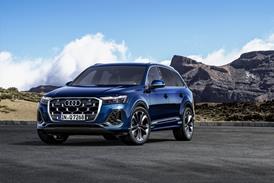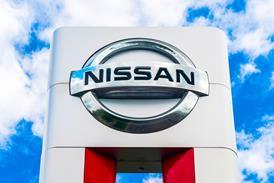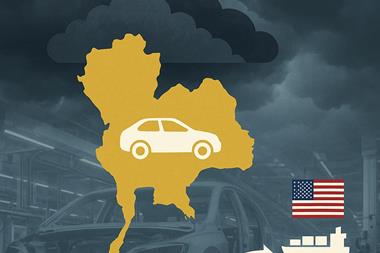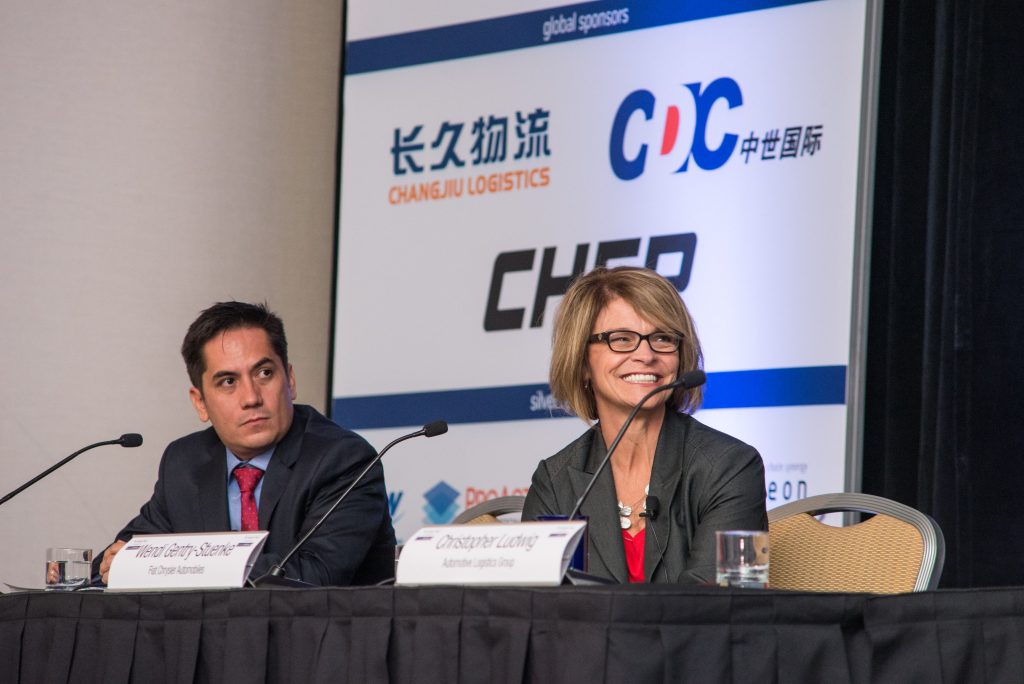
The rise in Mexican parts and production output is sending more material back and forth over the border, creating opportunities and challenges for intermodal services. However, Christopher Ludwig writes that manufacturers and 3PLs may need to change their organisations and approach to supplier relations to manage the growth
[sta_anchor id="1"]The growth of production and vehicle exports from Mexico remains, in many ways, the most compelling development in the North American automotive supply chain, and has led the trend towards ‘near sourcing’ or ‘re-shoring’ in the region. Anyone watching the market has probably memorised the figures by now: after a 50% rise in light vehicle production already this decade, to 3.4m units in 2015, the country is expected to approach 5m units over the coming years as more manufacturers open or expand plants.
In this story...
“Carmakers and suppliers are expanding in Mexico not just for geography or low costs, but also because of its good universities, research and development,” he said.
However, despite those advantages, the growth of the Mexican industry has also meant an extension of the overall North American supply chain, with more logistics, border, security, management and supplier issues for manufacturers to face.
For many, an effective intermodal logistics channel can be an effective tool to overcome many of these issues as it allows for faster crossings and pre-customs clearance in many instances. However, demand, capacity and supply do not always allow it. While trucking may offer more flexibility, it can also mean more risk, including having to switch equipment at the border, facing more security and customs checks, while also being susceptible to shortages of drivers.
Meanwhile, longer North American supply chain are clearly increasing the need for closer supplier relations – whether between OEMs and their tier one and tier two suppliers, as well as between manufacturers and logistics providers.
The intermodal question[sta_anchor id="2"]At Ryder, Calvillo pointed to issues that include unpredictable delays at the border, as well as gaps in the visibility of material at yards and in transit.
“In Mexico, there has been a lag in GPS and other visibility technology, although these barriers are starting to disappear,” he said.
For carmakers such as FCA, which has significant vehicle and engine production in Mexico, and is starting assembly of a Jeep model at its plant in Toluca, outside Mexico City, growth south of the border has made its supply chain even longer and more complex between the US, Canada and Mexico. The carmaker is currently one of the biggest users of intermodal transport between the three countries.
 FCA's inbound parts material modal split in North America – more stability in production and rail services are expected to benefit rail/intermodal this year
FCA's inbound parts material modal split in North America – more stability in production and rail services are expected to benefit rail/intermodal this yearWendi Gentry-Stuenkel, head of inbound logistics and automotive transportation at Fiat Chrysler Automobiles US, pointed to many issues in Mexico that can “keep you awake at night”, including border delays, security risks, labour shortages and supplier capacity issues.
The week of the conference, in fact, FCA had to cancel or reduce shifts at Jeep plants in Ohio and near Detroit, Michigan following shortages from an external supplier in Mexico.
For FCA, intermodal can be an important tool, together with fast customs clearance programmes, in bypassing some bottlenecks at the border. Thanks in part to the carmaker’s production and supply chain geography, with a concentration of plants in the Midwest and Canada, along with component and vehicle production in northern and central Mexico, FCA currently uses more rail and intermodal for parts than most of its OEM competitors in North America, according to Gentry-Stuenkel. After intermodal use fell in 2014 for FCA following production spikes and capacity issues on the railways (see chart above) –a drop that resulted in a rise in trucking of nearly 55m miles – the carmaker’s intermodal share of inbound logistics grew from 40% to 44% between 2014 and 2015.
This year Gentry-Stuenkel expects “a big increase” in intermodal flows. One reason is that FCA’s production volumes is expected to remain more stable compared to recent years. At the same time, carmakers are finding excess capacity and lower prices on the railways following declines in coal and energy commodities.
Gentry-Steunkel’s colleague in outbound and Mexico logistics, Marc Brazeau, told Automotive Logistics earlier this year that he was expecting similar benefits from railway stability across North America this year for vehicle logistics as well.
Steve Rand, executive vice-president for automotive and rail relations from intermodal provider Hub Group, pointed out that North American railways were still seeing revenue from commodities like coal decline by 40% or more year-on-year. That drop, together with the growth between the US and Mexico, is leading some class one railways to re-engineer their networks to provide more intermodal services, including for automotive customers.
“I think we’re seeing an industry in transformation,” he said. “One railroad, whose name I won’t mention, is re-purposing surplus locomotives from serving coal to make them available to serve intermodal and automotive trains.”
 "You would think that with longer lead times in North America, [intermodal] should be competitive and flexible. But we see this flow as extremely congested. Although there have been efforts to increase lanes, we have had to put aside our intermodal concept." - Paulo Monteiro, Volkswagen Group of America
"You would think that with longer lead times in North America, [intermodal] should be competitive and flexible. But we see this flow as extremely congested. Although there have been efforts to increase lanes, we have had to put aside our intermodal concept." - Paulo Monteiro, Volkswagen Group of America
Gentry-Stuenkel has been encouraged by the service and costs for intermodal both in and out of Mexico and Canada – also an important trade lane for FCA – however she is wary about assuming this will be a permanent change.
“We’re taking advantage of a down market [for rail], though we have questions about whether it will be sustainable as energy commodities recover,” she said.
Steve Rand also suggested that, because of growing automotive production in both Mexico and the South of the US, the next “intermodal superhighway” would be between the US south east, including Atlanta, and various points in Mexico.
While Detroit-based carmakers generally use a lot of intermodal between the US and Mexico, other carmakers, including those in the South, such as Volkswagen and Nissan, have used it less often. Instead, these OEMs depend mostly on long distance truck routes, which can be more flexible than intermodal. Paulo Monteiro, inbound logistics manager at Volkswagen Group of America, said that the carmaker currently uses truck for 100% of the material going into its plant in Chattanooga, Tennessee, including for parts and engines coming from Mexico.
 Ryder's Calvillo thinks Mexico's supply chain benefits and 'know-how clusters' are part of what is attracting more OEMs
Ryder's Calvillo thinks Mexico's supply chain benefits and 'know-how clusters' are part of what is attracting more OEMs“We have great service at ports and over-the-road carriers, but where we really struggle, to be honest, is intermodal transport,” he said. “You would think that with longer lead times in North America, it should be competitive and flexible. But we see this flow as extremely congested. Although there have been efforts to increase lanes, we have had to put aside our intermodal concept.”
Despite the current low costs and available service capacity on intermodal, other executives at the conference have also admitted privately that trucking carriers continued to offer lower prices in many instances.
Intermodal flows can also prove difficult for tier suppliers, depending on their volume and destinations in North America. John Godfrey, vice-president of NAFTA logistics at tyremaker Pirelli, said that high demand for tyres out of Mexico, as well as congestion in parts of the intermodal network, such as Chicago, was limiting his use of intermodal. Currently, Pirelli sends 80% of tyres built at its factory in Silao, Mexico north of the border by truck, and only 20% by intermodal.
“We’re trying to reverse this trend,” he said.
Who do I call to speak to Mexico?[sta_anchor id="3"]For others, the growth of Mexico has challenged existing management standards, forcing some organisational changes or adjustments at carmakers and logistics providers. Darcee Scavone, Ryder’s vice-president and general manager for automotive, aerospace and industrial supply chain operations, said that in some cases the increasing tendency for US-based manufacturers to centralise purchasing and logistics teams in the US presented conflicts or contradictions when dealing with local teams on the ground in Mexico who might not be aligned with the same strategy.
“There is a lot of back and forth. We are all trying to find a consensus on a seamless flow between the US and Mexico, but are we are not there yet,” she said.
“Ryder is not even necessarily aligned that way in Mexico,” she added. “We’ve usually had two different vice-presidents, two sets of objectives, different bonus grids, etc. It’s very challenging.”
However, as the market changes, companies are changing, including Ryder. Scavone said that the company had been working hard to present “one face of Ryder” to OEMs given growing investment in Mexico. Although she has responsibility for customers in the US, she often gets involved directly with her counterparts on both sides of the border, since the two businesses are so intertwined.
 "We are all trying to find a consensus on a seamless flow between the US and Mexico, but are we are not there yet... Ryder is not even necessarily aligned that way in Mexico. We’ve usually had two different vice-presidents, two sets of objectives, different bonus grids, etc. It’s very challenging" - Darcee Scavone, Ryder
"We are all trying to find a consensus on a seamless flow between the US and Mexico, but are we are not there yet... Ryder is not even necessarily aligned that way in Mexico. We’ve usually had two different vice-presidents, two sets of objectives, different bonus grids, etc. It’s very challenging" - Darcee Scavone, Ryder
Mexican growth is also leading to an important transformation in the way that the Volkswagen Group is organised in the US and North America. Until now, its Chattanooga plant has operated separate logistics and tenders from those in Mexico, which include a large assembly plant in Puebla and an engine plant in Silao. Now, with a new Audi factory opening in Mexico, and Chattanooga and Puebla both slated for expansion, the carmaker is moving towards the creation of a shared network for the plants and supply base, which will operate in a way that more closely resembles the group’s network in Europe.
“In the US we have not been working together [with Mexican plants] and each plant has had its own remit,” said Paulo Monteiro. “Now we are combining to work with the same service providers. If I can put more volume on the table, I can get better prices and more efficiency.”
Supply chain amigos[sta_anchor id="4"]For most manufacturers, however, the way to improve US-Mexico flows will not depend only on transport mode or even organisational changes, but instead on close relationships and communication throughout the supply chain.
Honda, which now has two factories in Mexico, has so far been moving a relatively small amount of material northbound to the US and Canada, and so the company often still lacks scale on its own to build full transport and intermodal loads. Kevin Wade, senior staff administration for transportation at Honda of America said that the carmaker is analysing each of its suppliers individually to decide if Honda has the density to manage its logistics northbound or if it should leave it to the “more mature” networks of the suppliers themselves.
“That takes a lot of time and energy from our team to make sure we get the analysis right,” he said. “When once we do that, we make sure we do it right and follow up with suppliers and logistics providers.”
At FCA, Wendi Gentry-Stuenkel emphasised the need to reduce potential risk at every handover point and with every partner in the supply chain across North America. That is why the carmaker has recently started to adapt a well-established supplier assessment tool, the AIAG’s material management operations guideline (MMOG), for logistics carriers.
So far, around 30 onsite assessments have taken place between September 2014 and the end of last year. According to Gentry-Stuenkel, the response from carriers has been very positive, with many addresses issues turned up in the assessments before FCA even arrives.
“I have seen many improved performances in our scorecard. In fact, very little now distinguishes our top carriers within the top quartile of performers,” she said.
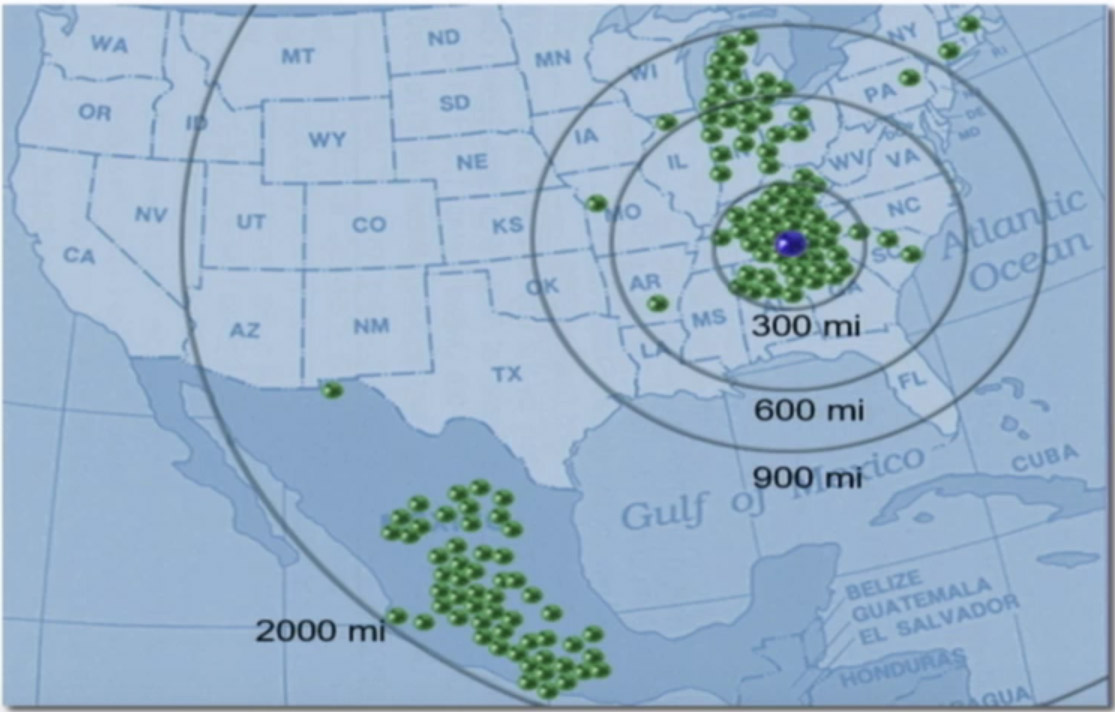 Around 6% of Volkswagen's inbound transport to Chattanooga come from Mexico, however more if its lower tier suppliers are also south of the border
Around 6% of Volkswagen's inbound transport to Chattanooga come from Mexico, however more if its lower tier suppliers are also south of the borderThe extent to which the lower tier supply chain stretches into Mexico and beyond is also a reason for OEMs to work more closely with their tier suppliers and logistics providers.
Volkswagen’s plant in Chattanooga, for example, currently receives 87% of transport material from the US and Canada, with 6% from Mexico and 7% from overseas.
However, its just-in-sequence suppliers, which are located in an adjacent supplier park, may have much longer supply chains, including deep roots in Mexico. For example, Chattanooga Seating Systems (CSS), a division of Magna Seating, receives 87% of its material from Mexico, according to Addam Prewitt, production and logistics manager. The seats also include vinyl suppliers based in Canada, as well as leather suppliers in Argentina.
With Volkswagen set to launch production later this year of a new, midsized SUV at in Chattanooga, which will nearly double the size of the plant, it is becoming even more important to have careful visibility over the lower tier supply chain. And as the plant only opened in 2011, the carmaker has already learned lessons from its early years of operation.
Communication with the supply base locally and in Mexico, for example, has proved vital, particularly in dealing with tier two or three suppliers. While Volkswagen directs much of the lower tier purchasing of its suppliers, it does not have direct control over the lower tier logistics chain, typically leaving this to suppliers. In the initial ramp up at the plant, however, Monteiro said that there were problems with supplier visibility, as well as in engineering changes that created more obsolete material at the plant than expected.
The carmaker decided to take a more engaged approach, developing visibility and co-management tools to share with suppliers in its supplier park.
For example, Volkswagen starting creating a more detailed ‘coverage confirmation report’, which incorporates more real time data on production schedules, changes and parts inventory. “OEMs often make multi-reading points available across the tiers, but the tier ones don’t use all the information that is out there,” said Monteiro. “In our supplier park, for example, most were only using the ASN message that told them when to produce in sequence – but there are other signals they can use.”
Addam Prewitt at CSS said that the reports helped the company to see the trucks that were set to arrive, allowing it to spot and react to potential reactions. In many instances the data would be reviewed together with Volkswagen to verify whether there really might be a parts shortage, and decide on necessary measures, whether it is premium freight or getting involved with a lower tier supplier. “For example, if a tier two suppliers is reluctant to spend money on overtime to make up the extra parts, there may need to be a conference call at the tier two together with us and Volkswagen,” said Prewitt.
Such methods demonstrate the hands-on approach often required from a carmaker’s logistics and material follow-up teams. “One approach is getting commercial guys involved, but often it is logistics that has to solve the problem,” said Monteiro. “Co-management [between OEMs and tier suppliers] is really important to managing the total supply chain.”
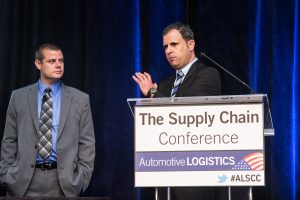 CSS's Addam Prewitt and VW's Paulo Monteiro emphasised a co-management approach for tracking lower tier suppliers, including those in Mexico
CSS's Addam Prewitt and VW's Paulo Monteiro emphasised a co-management approach for tracking lower tier suppliers, including those in MexicoThis close cooperation extends to third party providers as well. Volkswagen has a close relationship with a number of providers, including Ryder in the US and Mexico. “We try to create the conditions for real partnership, as that can save a lot of money for both entities,” said Monteiro.
While carmakers might leave their tier ones to make their own decisions, 3PL service to lower tier suppliers can also make a difference to OEMs. According to Prewitt, CSS made some initial missteps in its logistics outsourcing, trying to “save money” with the logistics provider it selected; the 3PL later fell behind and deliveries were impacting the seating plant, which was in turn going to disrupt Volkswagen.
“We had to collaboratively work together to come up with a new provider that would benefit both of us,” said Prewitt. “Volkswagen shared the resources they were using to allow us to quote on the business. It was not a mandate to say we had to use a particular provider, but they shared what could help us, at least in the interim. Eventually we found a good carrier. But the cooperation was key.”
Video recordings from the conference can be viewed here.
More coverage and information on Mexico can be found from the reports and videos from the 2016 Automotive Logistics Mexico conference.









